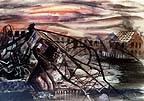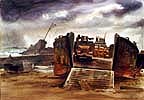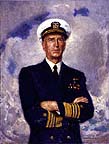 Pre-invasion:
Planning and Preparation
Pre-invasion:
Planning and Preparation |
The invasion of Normandy in June 1944 was the culmination
of three years of planning and preparation gathering by Allied
forces in Britain. Landing in the face of determined German resistance,
units of the British Commonwealth and U.S. armies established
a beachhead, defeated German counter-attacks, and eventually
broke out into a fast-moving campaign in France. By September
1944, Allied forces had liberated most of France and were poised
to cross the Rhine river into Germany itself. In conjunction
with Allied forces in northern Italy, and Soviet armies moving
into Poland and the Balkans, the total defeat of Nazi Germany
was in sight.
Instrumental to Allied success was the American, British, and
Allied naval and amphibious contingents at Normandy. In the year
before D-Day, U.S. and Commonwealth forces trained and prepared
for amphibious operations out of ports in southern England. In
the weeks leading up to the invasion, minesweepers cleared the
channel of mines while escorts and patrol aircraft attacked any
German submarines that tried to operate in the English Channel.
Battleships, cruisers and destroyers provided crucial bombardment
of enemy fortifications both on the Normandy shore and, with
the aid of Navy spotter teams, further inland. During the actual
invasion, navy-manned landing craft shuttled troops ashore in
the face of fierce enemy resistance. Once there, Navy beach battalions
served under fire to facilitate the orderly flow of men, vehicles,
and supplies from cargo and amphibious ships offshore. Navy field
hospitals also provided aid to the wounded and transported them
to ships for the voyage to hospitals in England.
Through all phases of the operation Navy combat artists Dwight
Shepler, Mitchell Jamieson and Alexander Russo observed and recorded
different aspects of this vast and complicated campaign. Though
it was also filmed and photographed, the artwork they created
helps convey a sense of the feelings and emotions behind the
events. This exhibit presents all the art work produced before,
during, and after the invasion by these three men.
There is a Traveling
exhibit for Normandy which contains selected works and some
addition works documenting London and other operations before
the prepration of the invasion began. the exhibit contains a
total of 64 works. |
 Beyond
the Beach
Beyond
the Beach |













